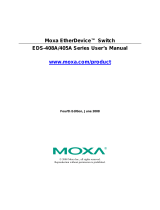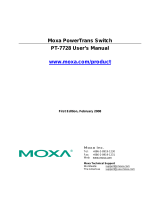
Table of Contents
1. Introduction to Redundancy Protocol ................................................................................................... 4
2. Turbo Ring ............................................................................................................................................ 6
The Turbo Ring Concept ......................................................................................................................... 6
Setting up “Turbo Ring” or “Turbo Ring V2” ............................................................................................... 6
Determining the Redundant Path of a “Turbo Ring” Ring...................................................................... 7
Determining the Redundant Path of a “Turbo Ring V2” Ring ................................................................. 8
Ring Coupling Configuration ............................................................................................................. 8
Dual-Ring Configuration (applies only to “Turbo Ring V2”) ................................................................. 10
Dual-Homing Configuration (applies only to “Turbo Ring V2”) ............................................................ 10
Configuring “Turbo Ring” and “Turbo Ring V2” ......................................................................................... 11
Configuring “Turbo Ring” ............................................................................................................... 11
Configuring “Turbo Ring V2” .......................................................................................................... 13
3. Turbo Chain ........................................................................................................................................ 16
The Turbo Chain Concept ...................................................................................................................... 16
Setting Up Turbo Chain ........................................................................................................................ 16
Configuring “Turbo Chain”..................................................................................................................... 17
Head Switch Configuration ............................................................................................................. 17
Member Switch Configuration ........................................................................................................ 17
Tail Switch Configuration ............................................................................................................... 18
4. STP/RSTP/MSTP ................................................................................................................................. 20
The STP/RSTP/MSTP Concept ................................................................................................................ 20
What is STP? ............................................................................................................................... 20
How STP Works ............................................................................................................................ 22
Differences between STP, RSTP, and MSTP ...................................................................................... 23
STP Example ....................................................................................................................................... 23
Using STP on a Network with Multiple VLANs ........................................................................................... 24
Configuring STP/RSTP .......................................................................................................................... 25
Configuring MSTP ................................................................................................................................ 28
Configuration Limits of STP/RSTP ........................................................................................................... 31
5. MRP .................................................................................................................................................... 32
The MRP Concept ................................................................................................................................. 32
Roles in MRP ................................................................................................................................ 32
How MRP works? .......................................................................................................................... 32
MRP Interconnection ..................................................................................................................... 33
Setting up “MRP” ................................................................................................................................. 34
Step by Step Setting for MRP Manager ............................................................................................ 34
Step by Step Setting for MRP Client ................................................................................................ 34
Step by Step Setting for MRP Interconnection .................................................................................. 34
Configuring “MRP” ............................................................................................................................... 35
Explanation of “Status” Items ........................................................................................................ 35
Explanation of “Settings” Items ...................................................................................................... 36
Explanation of “Interconnection Settings” Items ............................................................................... 37
6. V-ON ................................................................................................................................................... 38
The V-ON Concept ............................................................................................................................... 38
V-ON Topology .................................................................................................................................... 39
Overall Network Fast Recovery ....................................................................................................... 39
Local Network Fast Recovery ......................................................................................................... 40
Instructions for Setting Up V-ON ........................................................................................................... 41























